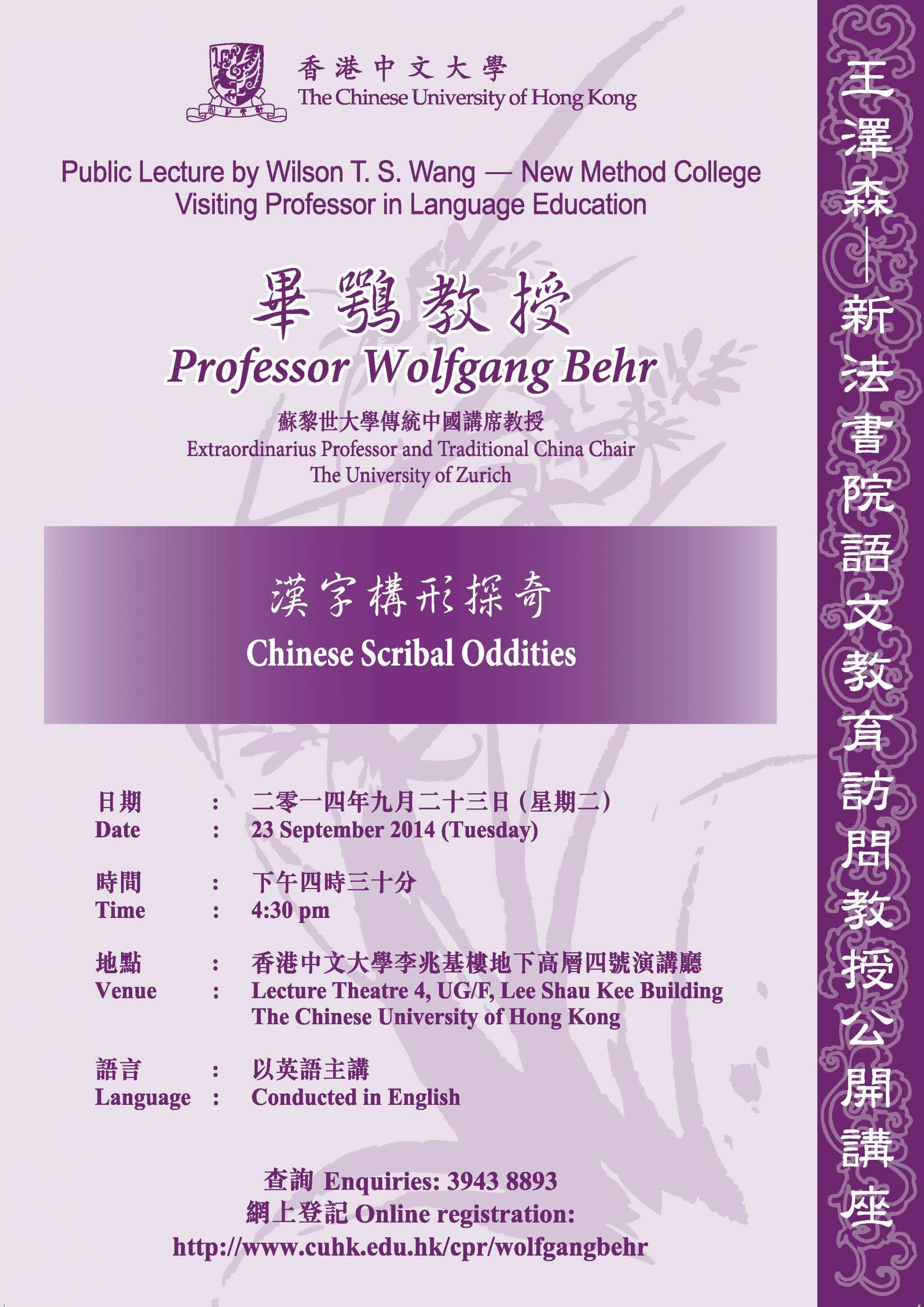Events
Wilson T.S. Wang – New Method College Visiting Professor in Language Education Public Lecture by Professor Wolfgang Behr on Chinese Scribal Oddities (in English)
23 Sep 2014
4:30 pm
Lecture Theatre 4, UG/F, Lee Shau Kee Building The Chinese University of Hong Kong
Professor Wolfgang Behr read Sinology, Slavic Studies, Indo-European and Comparative Linguistics and Sociology at universities in Frankfurt, Shenyang, Changchun and Moscow, receiving his doctoral degree in Sinology in 1997 from the J.W. Goethe University in Frankfurt. He held positions at institutes in Leiden and Uppsala and as University Lecturer at the Ruhr-University, Bochum. He is now Extraordinarius Professor and Traditional China Chair at the University of Zurich. He is currently an Executive Board Member of the European Association for Chinese Studies (EACS) and the Swiss Asia Society and on the Board of Directors of the Li Fang-Kuei Society for Chinese Linguistics. He has served as President of the European Association for Chinese Linguistics (EACL) for four years. His research interests include old Chinese phonology, morphology, etymology and paleography, Sino-Tibetan linguistics, external contacts of old and ancient Chinese, history of Chinese philology, epistemological foundations of historical linguistics, pre-imperial Chinese archaeology and history, early Chinese historiography, Sanskrit-Chinese translation and lexicography, etc. He has published extensively in scholarly journals and edited volumes including Sinica Leidensia, Bochumer Jahrbuch zur Ostasienforschung, Asiatische Studien, Historiography East and West, Journal of Chinese Philosophy, etc. His book, Reimende Bronzeinschriften und die Entstehung der chinesischen Endreimdichtung (2008), provided an account of rhyming bronze inscriptions and the origins of Chinese end-rhyme versification. He is also the co-author of Antikchinesisch – Ein Lehrbuch in drei Teilen (2005), written as a textbook of Antique Chinese. He is currently working on several book projects and the edition and translation of the Zhào wáng huĭ shì manuscript of the Shanghai Museum corpus.
3943-8893
In Western popular literature, the Chinese writing system is often portrayed as being mind- bogglingly complex and idiosyncratic, while the typical sinological narrative, in China as well as abroad, still prefers to analyse character structures in terms of the six categories of writing (liù shū 六書) inherited from the Shuōwén (說文) tradition. If the popular Western account, harkening back to the first missionary treatments of Chinese in the 16th century, tends to look for complexity in all the wrong places, the Eastern Han liù shū theory and most of its later derivatives notoriously mix up functional and structural layers, emic and etic perspectives. It thus fails to capture some of the less mainstream character construction principles, odd at first sight, but intriguingly recurrent throughout the history of Chinese writing.
My lecture will approach these fairly marginal character structures from the vantage point of a comparison with examples from other complex logographic writing systems of the Ancient world, such as Egyptian, Hittite and Sumerian, and it will point to parallels and remnants of such structures in the areal Sino-Xenic logographies developed in close contact with Chinese (such as Sino-Miao, Sino-Vietnamese, or Yi). Complexity, whether seeming or real, of the Chinese writing system, will thus be put into a typological perspective and complemented by some recent psycholinguistic insights into Chinese character processing. It is hoped that such a ‘sidelong glance’ from the margins will help to address the perennial questions of why mainstream Chinese writing ‘failed’ to develop into syllabic or even subsyllabic writing, and how the notion of writing system oddity can be usefully complicated if acquisition, performance and play are better separated.


